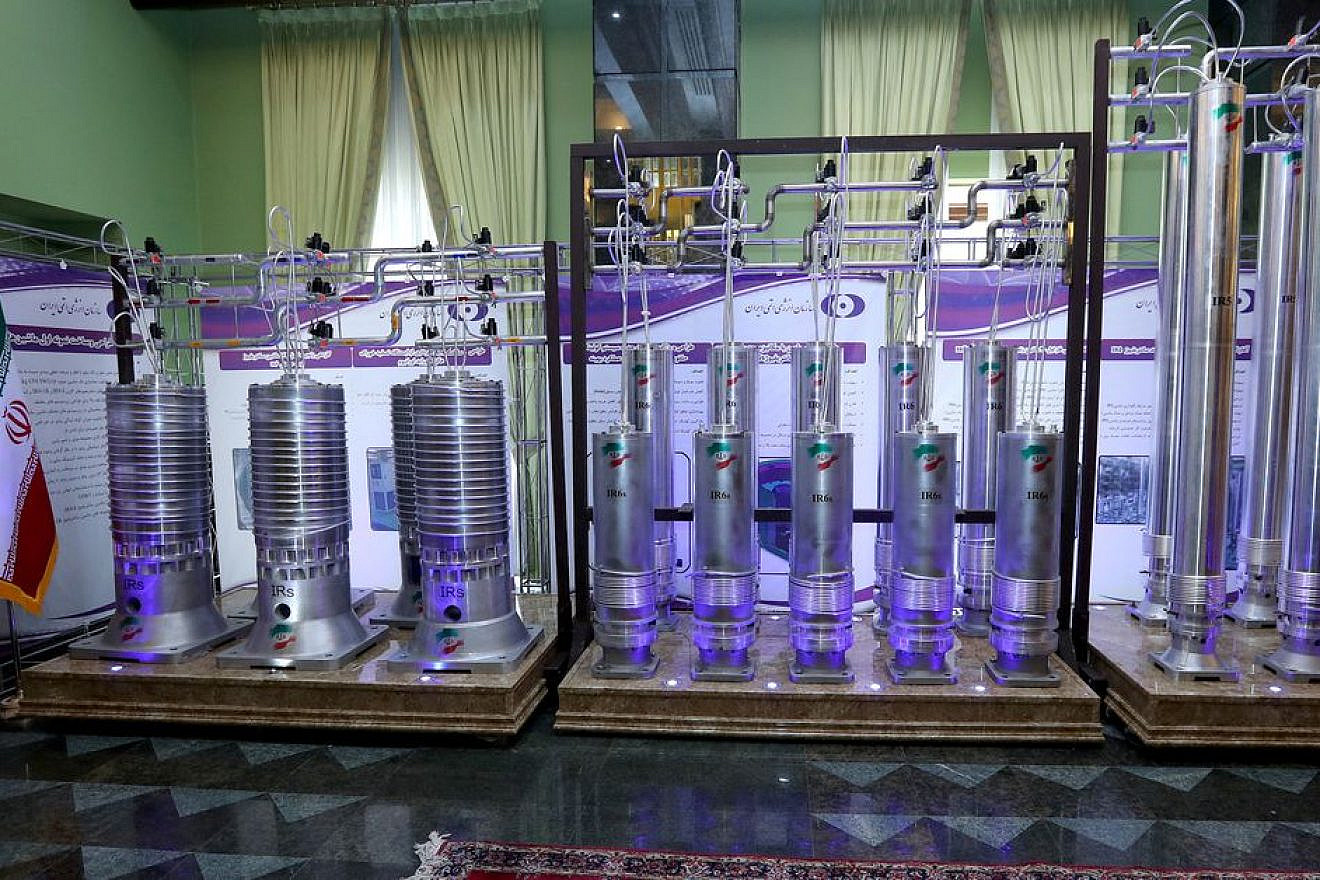by Menachem Wecker
The Pentagon’s recent announcement that Iran is less than two weeks away from having the materials for a nuclear bomb is significant, although it’s not necessarily breaking news.
 |
New-generation centrifuges on display in Tehran
during Iran's National Nuclear Energy Day, April 10, 2021. Credit:
Iranian Presidency Office/WANA. |
The U.S. Department of Defense’s recently released strategy to counter weapons of mass destruction records what has been known for months—that Iran “has the capacity to produce enough fissile material for a nuclear device in less than two weeks.” The Pentagon claims that Tehran isn’t pursuing a nuclear-weapons program but adds that chemical weapons remain a concern.
“It’s always interesting to see things in actual writing. It is not the first time that it has been reported and assessed that Iran is within two weeks of potentially having enough enriched material to test a nuclear weapon,” Robert Greenway, director of the Heritage Foundation’s Center for National Defense, told JNS. “But whenever you see it acknowledged by the U.S. government, the intelligence community, the Defense Department, it’s telling.”
Michael Rubin, a senior fellow at the American Enterprise Institute whose research areas include Iran, told JNS that “the Defense Department doesn’t really have the ability to know.”
“What is clear, however, is that Iran is pursuing all the elements necessary to make a nuclear weapon,” he said. “Pentagon spin also treats Americans as fools. After all, the difference between a nuclear-weapons capability and nuclear-weapons possession could be as little as the turn of a screw.”
The strategy thus represents the Pentagon’s acknowledgment that Iran has more capabilities. “The question this raises is whether inspections occur within that two-week window, or whether this is the Pentagon’s way of acknowledging Iran could build a bomb and surprise Washington,” Rubin said.
A three-legged stool
The Pentagon regularly assesses the degree to which Iran approaches the ability to create nuclear weapons. What is new is that it decided to publish the two-week time frame, according to Greenway.
“I think the calculation here is that you can’t ignore it. It would look ridiculous. It would make news if they omitted it, or if they were vague on what the Iranian threshold and breakout time was,” he told JNS. The publication was also probably intended to send messages to Iran and to Israel, and to U.S. partners and allies,” according to Greenway.
“I would argue it’s probably sending the wrong one,” he said. “Every time you bring this up, two things inevitably follow. One is: ‘How did we let this happen?’ and ‘What are we doing about it?’ Unfortunately, on both scores, the administration has failed.”
Iran’s accelerated timeline, the number of its centrifuges and the percentage of its enrichment have all happened “not exclusively but largely” under the administration of U.S. President Joe Biden, according to Greenway. (Iran was part of Greenway’s portfolio as a senior official in the Trump administration.)

When Biden assumed office, Iran had enriched uranium to about 4%. At one point since, it had reached 84% “but is now hovering above 60%,” Greenway told JNS. In the same time span, Iran has gone from about 500 advanced centrifuges to about 3,000, he said, adding that “inevitably, this is going to look bad.”
Despite U.S. President Donald Trump’s administration withdrawing from the 2015 nuclear deal—officially the Joint Comprehensive Plan of Action (JCPOA)—Tehran still remained at 4% enrichment levels “not because they didn’t have the capacity to do it,” Greenway said, but because they judged the previous president as “a sufficient deterrent credibility. They knew, believed, that he would take decisive action if they were to escalate on enrichment.”
The Trump administration also placed onerous economic sanctions on Tehran, whereas the Biden administration has done the opposite with its $6 billion recent “ransom,” he said.
Iran would need to create three legs of a stool to launch a nuclear attack, according to Greenway. It would need to enrich fuel, whether uranium or plutonium, which it has been doing steadily; it would have to create a delivery system, a missile or other sort of bomb with which to launch the weapon; it would require a warhead.
“The reality is that we don’t know how close they are,” he said. Iran already has demonstrated the ability to launch a weapon as far as Europe, and certainly Israel, but not yet to the United States.
“The warhead also has complications, but historically, the biggest resource commitment has been on the enrichment, because the infrastructure to do that is incredibly expansive and very cost-prohibitive,” he said. “Right now, the only obstacle between Iran and a nuclear weapon is themselves. They’re standing in their own way, and there’s really no other constraint on them at the moment.”
‘Detonation of a dirty bomb’

Rubin, of AEI, questioned what the Defense Department means by Iran being able to obtain sufficient “fissile material” to make a nuclear weapon in two weeks.
“Too often, analysts assume that ‘enough’ means 20 kilograms of 90% enriched uranium, but the material for the Hiroshima bomb was enriched just to around 80%,” he said. “Detonation of a dirty bomb could be just as devastating to the world economy.”
As far as Rubin thinks, there’s no shortage of blame to go around for Tehran’s current proximity to nuclear weapons.
“Congress has been remarkably unserious for decades. Europe with a nod and wink helped provide cover for Iran,” he said. “But when the history is written, Jake Sullivan will share disproportionate blame. He sought to leverage the Iran diplomatic process into career advancement—never understanding the power structures of Iran, the insincerity of so-called Iranian reformists or how Iranians saw him as a useful idiot.”
Beyond Sullivan, the U.S. national security advisor, Rubin told JNS that former U.S. President George W. Bush’s team was ineffective “largely because Colin Powell and Dick Armitage always ran interference for the regime’s worst behavior and prioritized internecine Beltway warfare over American national interest.” (Powell was then U.S. secretary of state and Richard Armitage deputy secretary of state.)
“But the behavior of the Obama and Biden administrations really has been shocking,” Rubin said. “Yesterday’s fringe radicals are today’s Biden mainstream.”
‘No enrichment in Iran’

Andrea Stricker, deputy director of the nonproliferation and biodefense program at the Foundation for Defense of Democracies, told JNS that Biden is primarily at fault for his “unwillingness to shift back to pressure after it became clear Iran was exploiting his desire to restore the 2015 nuclear deal.”
“Tehran’s most egregious nuclear advances have occurred over the past nearly three years, allowing Iran to amass enough enriched uranium for 10 nuclear weapons,” Stricker said. “Now, the West is doing all it can to essentially bribe Tehran not to cross the nuclear threshold.”
She also laid some blame on the Trump administration, which “could have pushed through negotiations with our European allies to strengthen the nuclear deal and leave some limits in place.”
“The inherent push-pull, however, is that providing any sanctions relief for Iran is problematic absent meaningful changes to the regime’s policies,” she said. “No enrichment in Iran is the only foolproof nonproliferation standard.”
Stricker noted that Israel’s Mossad seized materials from Iran’s nuclear archive in 2018, which indicated that Tehran planned to hide nuclear weaponization within “plausible civilian purposes at research institutions and those with military applications at secure locations.”
“At a minimum, Iran likely has people working on furthering disparate weaponization activities and a rapid ability to reconstitute a nuclear-weapons program if the leadership orders it,” she said.
JCPOA constraint

Mark Bell, associate professor of political science at the University of Minnesota and author of the 2021 book Nuclear Reactions: How Nuclear-Armed States Behave, sees the Trump administration as the main party to blame for Iran being on the verge of having the material required for a nuclear weapon.
Based on public data, Bell thinks that it is plausible and reasonable that Iran has not yet made a final decision to acquire nuclear weapons.
“Iran’s ‘breakout time’ has been steadily declining ever since the United States withdrew from the JCPOA during the Trump administration, so we have been coming gradually closer to this point for a while now,” he told JNS.
“The JCPOA was keeping the Iranian nuclear program constrained, and Iran was complying with its requirements under it. Ever since the Trump administration removed those constraints by abandoning the JCPOA, Iran’s stockpiles of nuclear materials have unsurprisingly increased,” he said. “So I would point to the Trump administration’s withdrawal as being the key decision that has gotten us to this point.”
Menachem Wecker
Source: https://www.jns.org/blame-all-around-for-iranian-proximity-to-nukes-say-policy-experts/
No comments:
Post a Comment